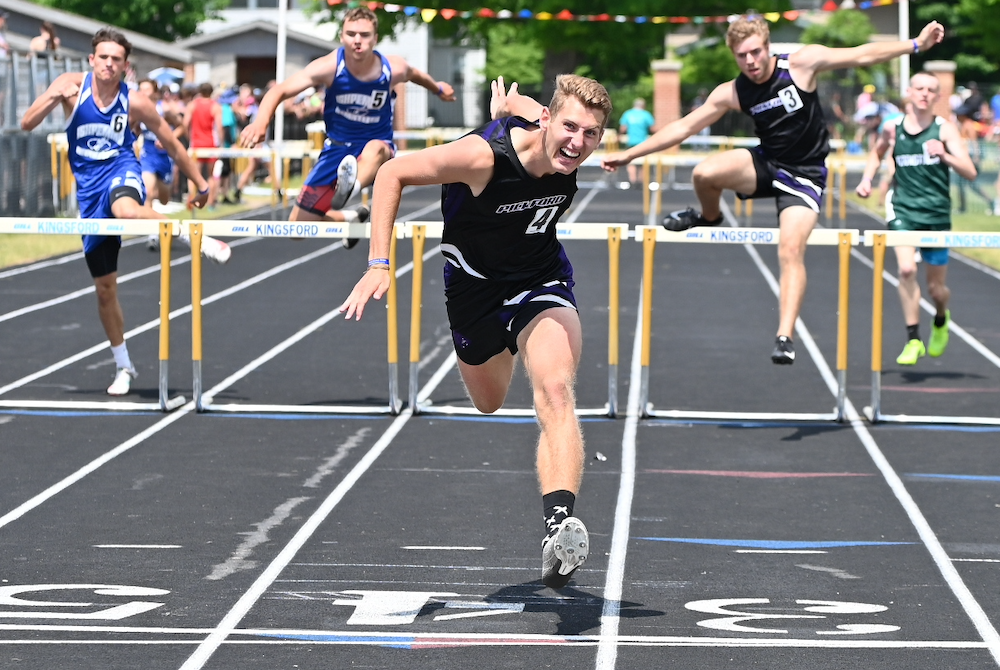
Kozisek's Rare Feat Helps Pickford to Impressive Rise & Title Repeat
By
Jason Juno
Special for MHSAA.com
June 4, 2023
KINGSFORD – The Pickford boys moved up a division after winning last year’s Upper Peninsula Division 3 Track & Field Finals title. And it didn't faze them a bit.
They dominated the field Saturday, finishing with 151 team points. Manistique was second with 90, Ishpeming third with 87 and St. Ignace fourth with 73.
In the process, Pickford ended the Hematites' four-year run on top of Division 2.
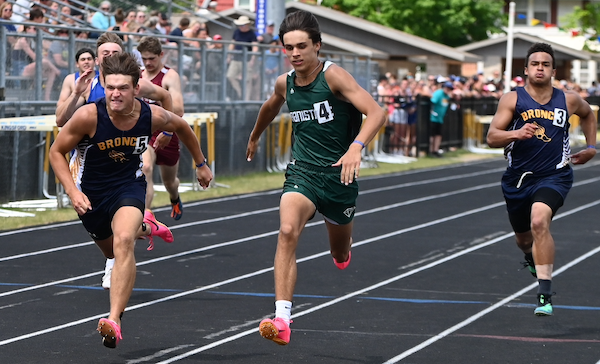 The Panthers won nine of the 17 events. Hayden Hagen won all of the distance events and David Kozisek won both of the hurdle races along with the high jump and long jump to become just the ninth male athlete to win four individual events at an MHSAA Finals. Brayden Altoft took home a first in the shot put as did the 400 relay team (Cole Warner, Kendrick Brace, Altoft and Owen McConkey).
The Panthers won nine of the 17 events. Hayden Hagen won all of the distance events and David Kozisek won both of the hurdle races along with the high jump and long jump to become just the ninth male athlete to win four individual events at an MHSAA Finals. Brayden Altoft took home a first in the shot put as did the 400 relay team (Cole Warner, Kendrick Brace, Altoft and Owen McConkey).
One of the more exciting finishes of the day came in the 200-meter dash when Bark River-Harris’ Kavin Fredrick dove for the win ahead of Manistique’s Wyatt Demers.
Demers was Fredrick’s biggest concern. Why? He’s really fast, and he usually beats him in the 200.
Fredrick led until about 50 meters to go, and he could see Demers’ arms coming up.
“So I thought to myself, ‘Well, I mean I’ve got to dive if I want this,’” he said.
And so he did.
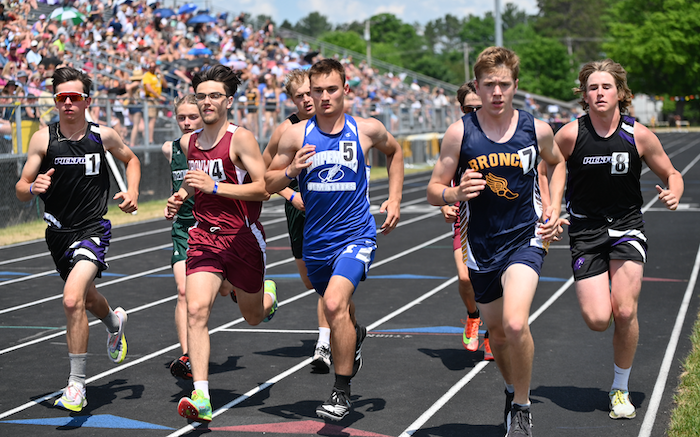 “I took a big dive and I won by a hundredth of a second,” Fredrick said. “I’m a little cut up, but totally worth it if you ask me.”
“I took a big dive and I won by a hundredth of a second,” Fredrick said. “I’m a little cut up, but totally worth it if you ask me.”
No, he hadn’t tried that before.
“It’s my first time ever diving and it worked, so I’d recommend it,” Fredrick said. “It feels great. I went in thinking it would be a tough race against a couple people that I was up against. And I actually did it, so that’s a good feeling.”
Demers picked up a Finals title in the 100 dash.
The Broncos also the 800 relay (Justin Bergquist, Fredrick, Cristian Spear and Vincent Martin). Manistique won two relays, the 1,600 (Grant Mason, Dillon Hayes, Carter Miller and Demers) and the 3,200 (Mason, Brenden Mead, Ben Gilroy and Austin Hinkson).
The Emeralds’ Mason was first in the 400.
In the field events, Ishpeming’s Brayden Martin won the discus and St. Ignace’s Owen Lester repeated in the pole vault.
PHOTOS (Top) Pickford’s David Kozisek crosses the finish line first in the 300 hurdles Saturday. (Middle) Bark River-Harris’ Kavin Frederick and Manistique’s Wyatt Demers race for the finish line, with Frederick crossing first by one hundredth of a second. (Below) Runners begin the 1,600, including eventual winner Hayden Hagen (1) of Pickford and runner-up Alex Korpela (4) of Ironwood. (Photos by Cara Kamps/RunMichigan.com.)
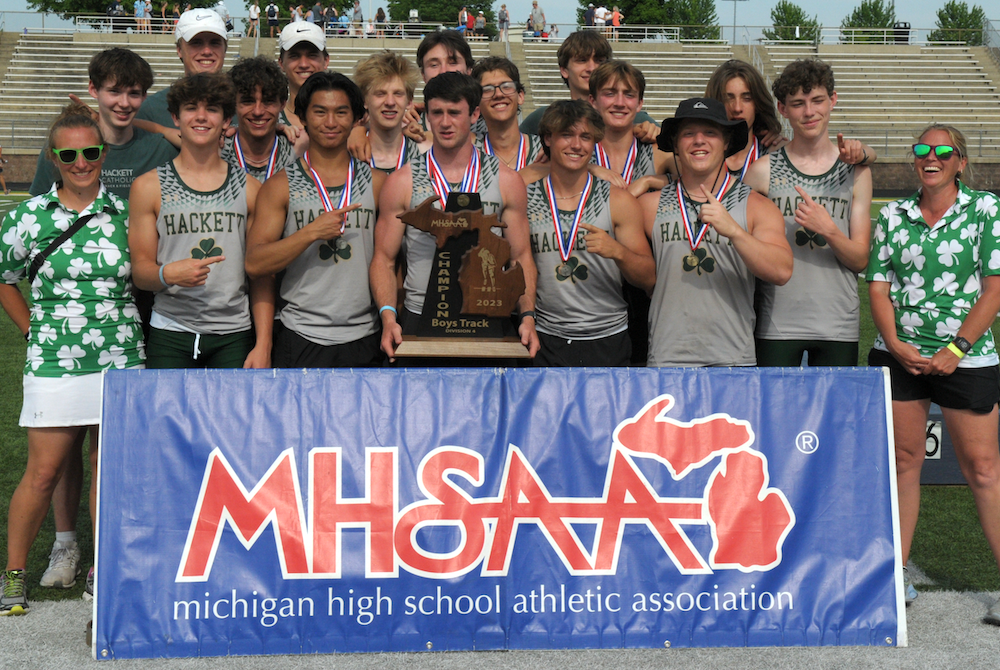
Thrower Claims Lone Individual Title to Lead Hackett to Team 3-Peat
By
Tom Lang
Special for MHSAA.com
June 3, 2023
Kalamazoo Hackett Catholic Prep just keeps winning and winning.
This time the Irish took home their fourth title in the last five Lower Peninsula Division 4 Track & Field Finals, on Saturday at Hudsonville.
Hackett’s only individual title was taken by discus winner Nathan Buchmann, a senior, who was fine knowing he was the shortest in stature among all the sizable competitors.
“In the offseason after football I worked out every day, working towards this goal,” he said after getting his medal. “I would say this takes 80 percent technique and 20 percent strength to throw the discus. So, length can help but if you have good technique and are really strong, that will play into it.
“I think we are very balanced throughout the meet today,” he said about teammates that scored points in finishes other than first place. “We have 13 guys here today, and we have people in a lot of the races. But I do not run; I have too short of legs to be a fast runner,” he said with a chuckle.
Buchmann had to work through a hip injury to compete this spring.
“I think the setbacks are what make you strong,” he said. “You can either give up through the setbacks or push forward and become better.”
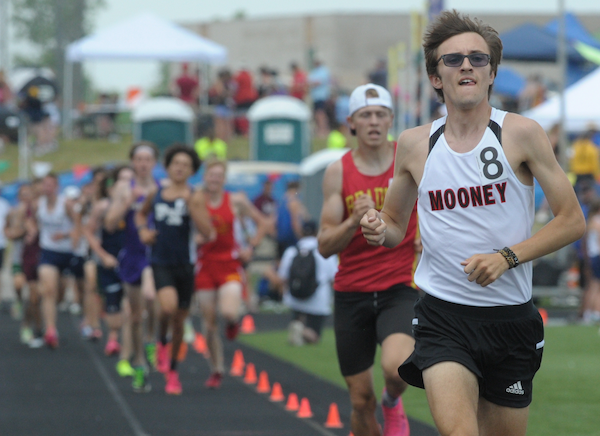 Coach Charissa Dean agreed.
Coach Charissa Dean agreed.
“The kids have big hearts,” she said after all the points were totaled and the Irish were on top once again, with 53. “They worked hard. They had a lot of potential when we started the season. And we had a lot of drive to put in the work, and we are happy the results came out the way they did.”
Reading was runner-up at 47 points, followed by Wyoming Potter’s House Christian with 42, then Fowler and Flint Beecher each with 37 points.
Senior Lezawe “Moses” Osterink, of Potter’s House Christian, placed second in 1,600 but took the 3,200 title as defending champ of both. He dominated the latter by lapping the field with a final lap kick that resembled more of a superhero speedster.
“Nobody really took it out that hard at the start,” he said. “There was a freshman (Marek Butkiewicz of Hackett) that tried to get the pace going quick, but me and Dakota (Dykhuis of Montabella) just kind of sat back and gradually pulled him through.
“We took it gradually, and I was just relying that I could kick.”
Kick did he ever. The trio were neck and neck the majority of the race in a grouping ahead of the pack.
“With 400 to go I just tried to go all out,” Osterink said. “I had a lot more left than I thought and I was pleased with the win. Not really the time, but that doesn’t matter, especially this hot out.”
The overall meet was in the low 90s/high 80s heat and searing sun all day. So, race officials allowed the unique opportunity for coaches to spray the runners with water and give them water bottles.
“It was very weird because I’ve never taken water to drink while I’m running, so I didn’t know how that would feel,” Osterink said. “And they were spraying us and hitting us in the face. It was kind of fun.”
Junior Tyler Lenn of Marine City Cardinal Mooney defeated Osterink at his own game in the 1,600.
“I’m feeling great,” Lenn said after grabbing the medal. “I said to a newspaper after one of my races (during the season) I was right where I wanted to be. This has been a long rebuilding process for me since an injury back in the fall, and I set a pretty high goal the day the injury happened. I was telling myself I needed to fulfill what I said I would do at the beginning of last cross country season. And that is what I did today.”
Lenn suffered an ankle sprain from a misstep that turned worse because he kept running through the season on it.
“Coming back from that was pretty tough, but I wouldn’t have it any other way,” he said. 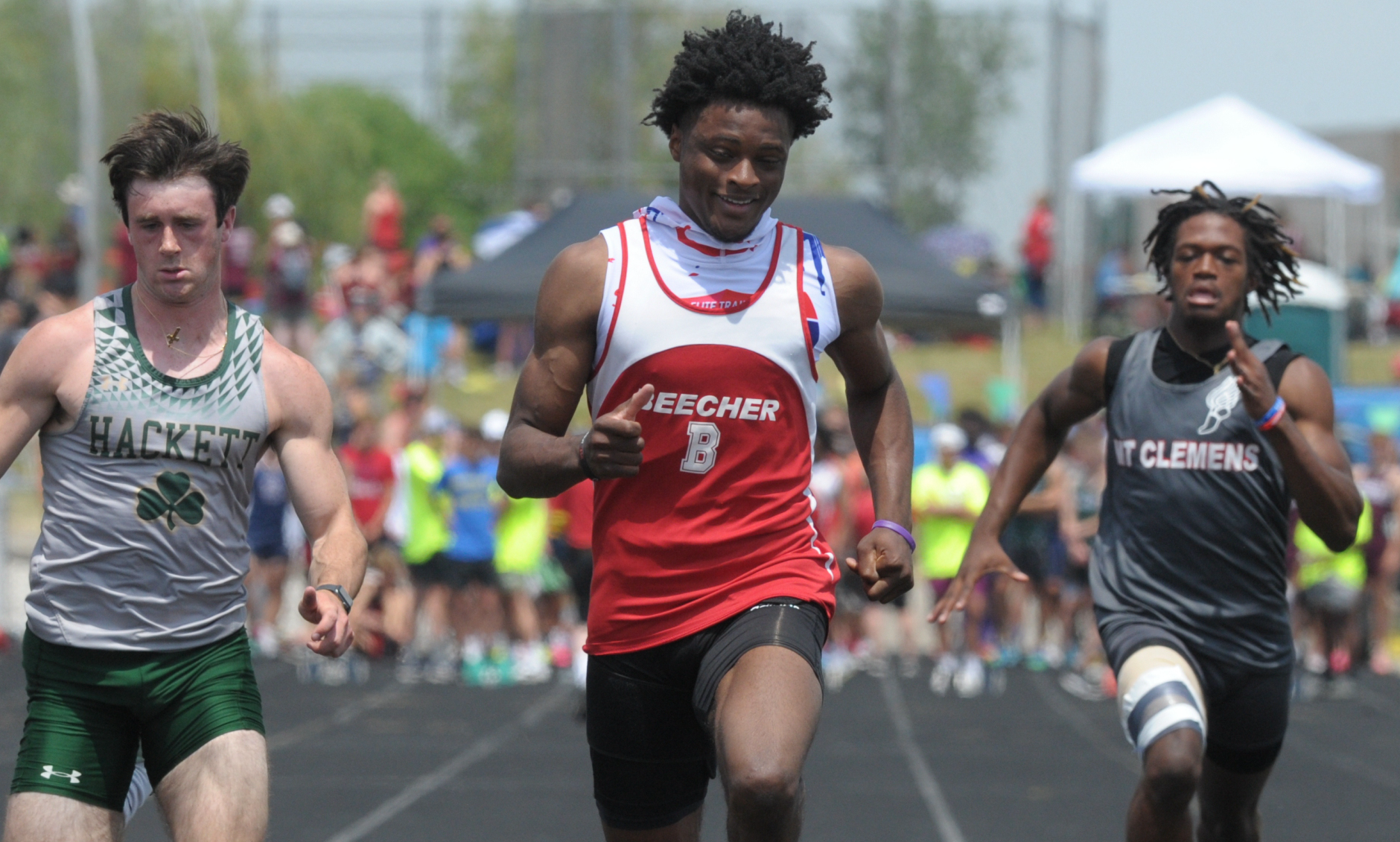 “Perseverance; I said from the beginning what I was going to do. I kept my eye on that target, and no matter the circumstances life threw at me, that I was going to make it happen and I am a man of my word.”
“Perseverance; I said from the beginning what I was going to do. I kept my eye on that target, and no matter the circumstances life threw at me, that I was going to make it happen and I am a man of my word.”
Jaylin Townsend, a senior from Flint Beecher, dominated the short races. He won the 100 dash (10.67) and 200 dash at 22 seconds flat. It was his third 100 win at a Finals.
“I put in a lot of work; I had to three-peat,” he said after the 100. “There’s a lot of great competition here, so I knew I had to come out and run my best.”
Concord in the 400 (43.72), Buckley in the 800 (1:30.76) and 1,600 (3:29.13) and Potter’s House in the 3,200 (8:14.18) were relay champs Saturday. Reading’s Tayshawn Bester won the 110 hurdles (15.13), and Athens’ Landen Bennett won the 300 (39.85). Caseville’s Nathan Feltner won the 400 (50.76), and Vestaburg’s Owen Patton claimed the 800 (1:55.11).
Fruitport Calvary Christian’s Bradley Richards won the high jump (6-10), and Peck’s Alex Affer won the long jump (23-4). McBain Northern Michigan Christian’s Isaac Bowden was first in pole vault (13-0), and Brown City’s Kyle Affer won shot put (49-2).
PHOTOS (Top) Kalamazoo Hackett Catholic Prep celebrates its third-straight LPD4 title Saturday. (Middle) Cardinal Mooney's Tyler Lenn, far right, sets the pace in the 1,600. (Below) Flint Beecher's Jaylin Townsend, middle, crosses the finish first for one of his two sprint championships. (Photos by Ken Swart/RunMichigan.com.)

